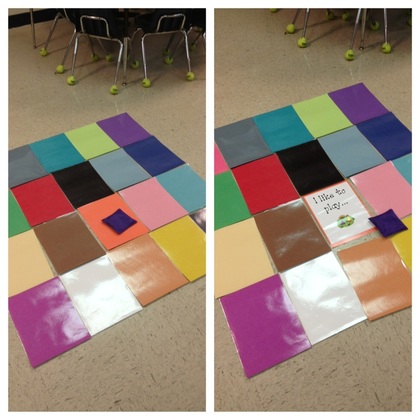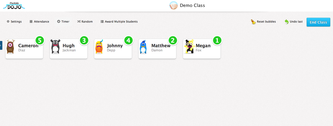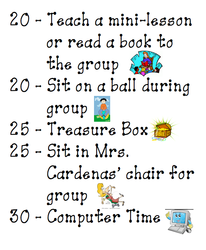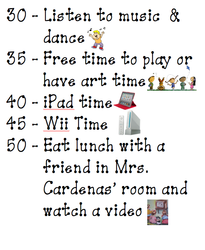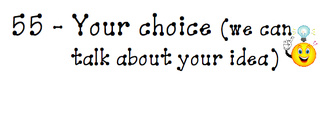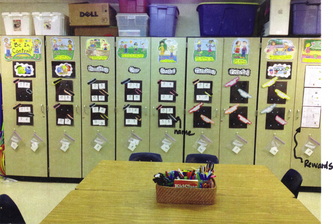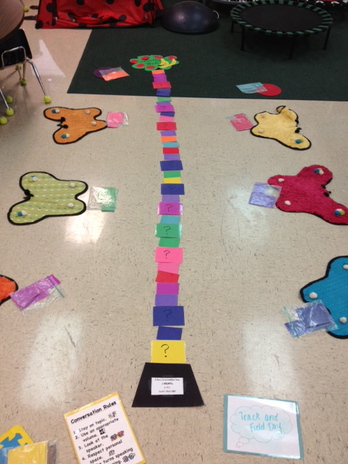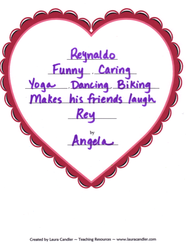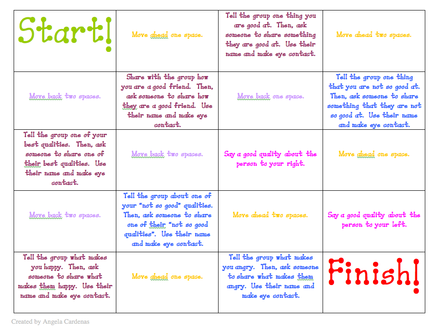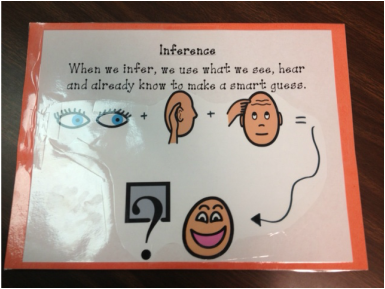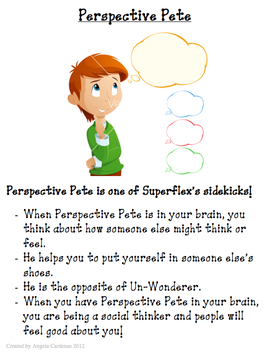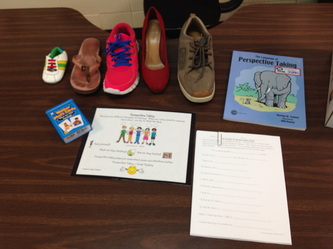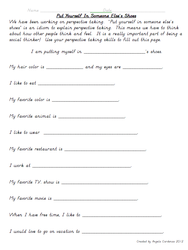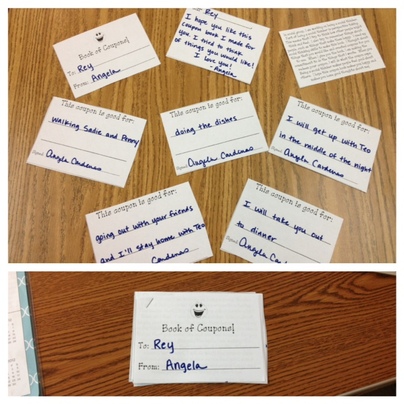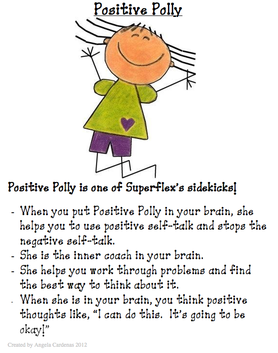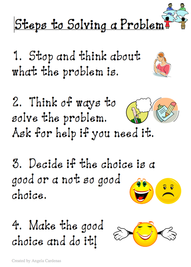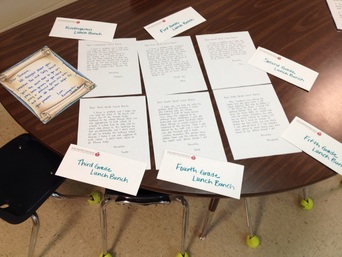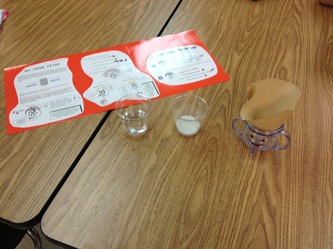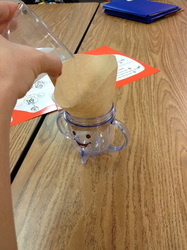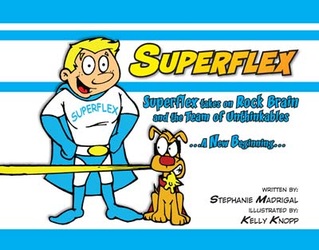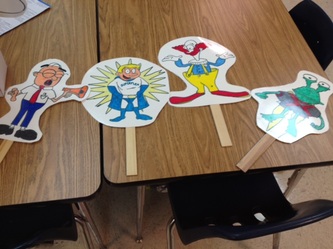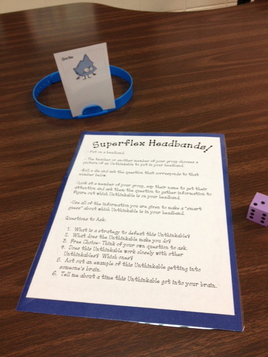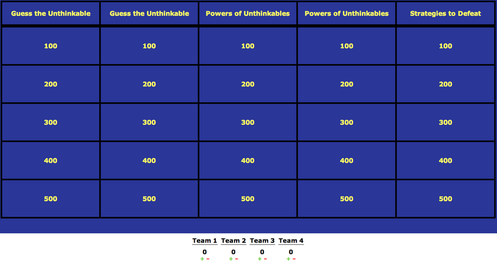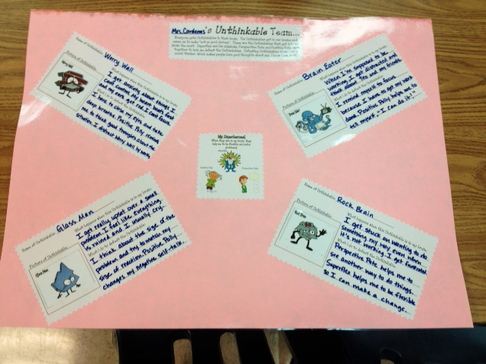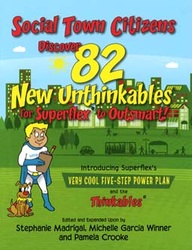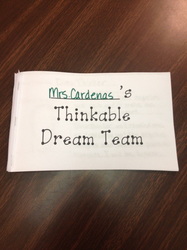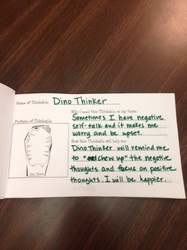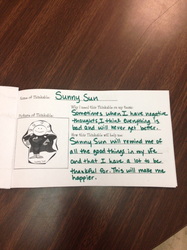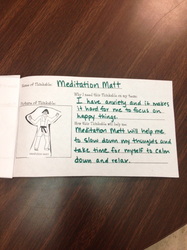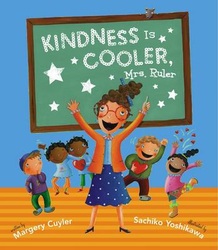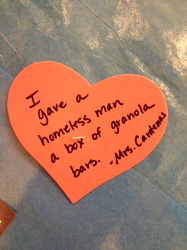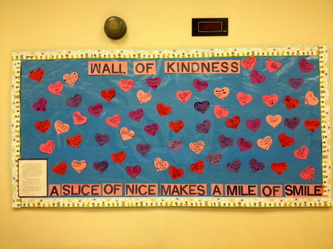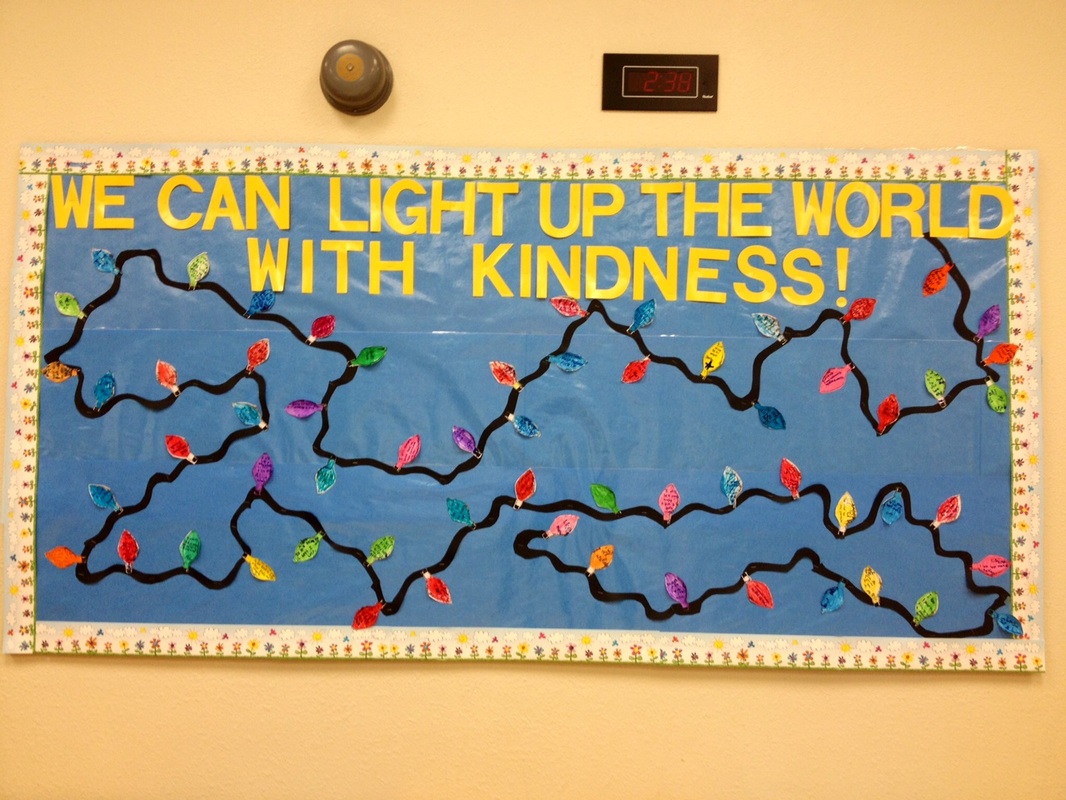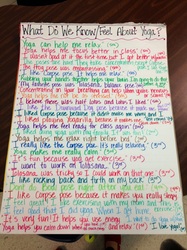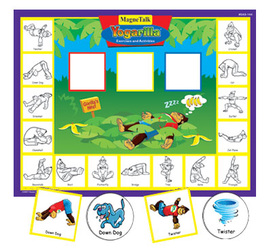Lesson Activities
This page contains various lessons. When using materials that I have created, please credit Angela Cardenas. Thank you!
A Rainbow of Friendship, Hand In Hand
I got this idea from here, but altered it a bit. We started by watching the video, "Friends" on BrainPop Jr. We discussed what we know about being a friend and shared stories with each other. Then, we read the book, How to Be a Friend by Laurie Krasny Brown and Marc Brown. Then, the students wrote what makes them a good friend on a small "paper pal". We used those to create this cute bulletin board. This is a fun activity when talking about friendship!
Bean Bag Conversation Game
I made this game a couple years ago. Forgive my memory, but I cannot remember if I got this idea from somewhere or if I came up with it on my own! Having children really does a number on our memory, yes?! For this game, I made various statement stems, printed, mounted on construction paper and laminated them. Each statement stem takes up an entire piece of paper. Some example statements are, "I feel happy when...; I get excited when...; If I won a million dollars, I would...; I like eating... etc." I made twenty statement stems, but you could easily do more or less. To play the game, I place all the pages face down on the floor. When it's a student's turn, they toss a small bean bag and turn over whichever page they land on. They read the statement stem and then complete that sentence. For example, "I feel angry when my little brother yells at me." After they complete the statement, they choose a peer and turn that statement into a question. Using the previous example, they would then say, "Johnny, what makes you feel angry?" This is a great way to encourage eye contact, keep a conversation going, teach follow-up questions and have them practice turning statements into questions. This is really helpful for my Speech impaired students as well as the rest of the kids. After that chosen peer answers the question, it is then their turn to toss the bean bag and the game continues in this manner. The kids get really excited when we play this game! At the end of the game, I ask them various questions to make sure they were paying attention and absorbing the information learned about each other. I connect this to our "Friend File" concept; when we learn something about someone, we store it in that person's "file" in our brain. So, I will ask questions like, "What makes Johnny angry? What is Mary excited about? What does Kathy like to eat?" This is a simple, easy to make and fun conversation game to play! Click below for a free download! Please credit Angela Cardenas when using my materials. Thank you!
| bean_bag_conversation_game.pdf | |
| File Size: | 3592 kb |
| File Type: | |
Bucket Fillers and Dippers
Both of these books are great for teaching how our behavior makes others feel. We read these books in social group and then filled out the attached sheet on behaviors that would fill a bucket as well as dip a bucket. We continue to use this language throughout our day. When I see the students demonstrating expected behaviors, I let them know that they are filling my bucket. I also tell them when something "really dips my bucket"!
| bucket filler/dipper.doc | |
| File Size: | 522 kb |
| File Type: | doc |
Class Dojo
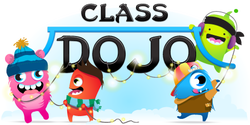
Class Dojo is a really great online management point system. Right now, it is free so I highly recommend setting up an account! You can use this system for many things. In my classroom, we are using it to keep track of our expected and unexpected behaviors. Instead of earning a sticker on their sticker chart after social group, they can now earn unlimited points based on their behavior and participation in group. I customized the behaviors that I am looking for, such as whole body listening, participation, helping others, being a social thinker, teamwork etc. I also customized the negative points, such as not following directions, arguing, not bringing homework etc. Throughout the lesson, I have the specific group's class up on my iPad so they can see their points. I give (and take) points throughout the group and give the students immediate feedback about why they are earning/losing a point. I believe this immediate feedback is critical for shaping behavior. At the end of group, we discuss how many points they have and they put that number up on the wall next to their name. I also created a list of rewards that students can "buy" with their Class Dojo points. See the pictures below for the various rewards they can redeem. I'm attaching the numbers we use for our display wall as well as my reward document. Feel free to download and use, but please credit Angela Cardenas when you do so.
The students are super motivated by this system! It's fun and they have the opportunity to experience positive rewards more often to encourage expected social behavior. Since Class Dojo has a free app, you can use it on your phone, iPad and computer. If I see expected behavior in the hallway, I can give them a point right then! This is a great tool that you could even utilize as a parent for home behaviors that your child may be working on. The opportunities are endless! We love it!
The students are super motivated by this system! It's fun and they have the opportunity to experience positive rewards more often to encourage expected social behavior. Since Class Dojo has a free app, you can use it on your phone, iPad and computer. If I see expected behavior in the hallway, I can give them a point right then! This is a great tool that you could even utilize as a parent for home behaviors that your child may be working on. The opportunities are endless! We love it!
| classdojo_numbers.pdf | |
| File Size: | 16 kb |
| File Type: | |
| classdojo_rewards.pdf | |
| File Size: | 3141 kb |
| File Type: | |
Conversation Chutes and Ladders
This is a conversation game we play in Lunch Bunch. Using a Chutes and Ladders game board, students move spaces when they participate in conversations. We start by picking a topic and then just start talking! This is a great visual for conversation skills and can show students the value of participating in the conversation. It also has a component of being a good sport when something doesn't go our way (ie. landing on a chute).
| conv_chutes__ladders.doc | |
| File Size: | 60 kb |
| File Type: | doc |
Conversation Tree
This activity is from Michelle Garcia Winner's book, Thinking about You, Thinking about Me. We start by discussing our conversation rules (take turns speaking and listening, look at the speaker, use appropriate volume, stay on topic, and respect personal space). We then go over what we want the tree to look like (tall, colorful, little/no branches). I have the expectations of what the tree should look like attached to the base of the tree. On the top of the tree are example question and comment stems they can use. Then I give each student a bag of same color construction paper pieces. The bigger squares represent a comment/statement. The smaller cards represent asking a question. The longer rectangular pieces are branches. Branches represent when a conversation rule is "broken", so we discuss that this is a special kind of tree because we want it to have little/no branches. After everyone has their cards, I introduce the topic. For my younger students, I pick the topic beforehand. My older students can steer the conversation more effectively so I let them choose the topic. I write the topic on a large thought bubble to remind us of what we should be thinking and talking about. As the conversation is going, students add their cards to the tree as they make comments and ask each other questions. Seeing the tree grow encourages the students to keep participating. For my reluctant talkers, I use a cue such as, "I'd love if our tree trunk had more orange in it." That way, I do not call that person out by name, but I am able to prompt them to participate in the conversation more. After we are finished, we discuss what we notice about the tree. We tie that back to our beginning when we talked about what we wanted the tree to look like (ie. "Is it tall? Is it colorful? Does it have branches?") I love this activity because it creates a visual anchor for what a good conversation looks like. The kids get really excited and usually want to challenge themselves to keep making the tree taller and taller!
Friendship Cinquains
I adapted this activity from Laura Candler. Instead of having the students interview a friend to complete the poem, students will write their poems based on what they already know about their friend. This ties in really well to perspective taking and friend files. To be a social thinker, you have to remember and be able to access information about friends. Students use this interview form and heart to complete their poem. A super social thinker would then give the poem to the person. That would surely fill someone's bucket! Here is mine that I made for my hub. Valentine's gift, check! ;)
Good Qualities Game
I created this game after seeing a similar one in the book, Talkabout for Children by Alex Kelly. I added a few things, like sharing feelings, things we are good at etc... This is a fun cooperative game to play in social group or lunch bunch. Students are encouraged to share their thoughts and feelings with each other and there is also a component of asking each other questions and making eye contact. The rules are simple, roll a die and move a game piece to that space. For every time the student has to share something, they get a marble. Whoever has the most marbles at the end of the game is the winner. Although, as teachers, we know the real winning is in the sharing of thoughts and ideas!
| good_qualities_game.doc | |
| File Size: | 29 kb |
| File Type: | doc |
Hopes and Dreams for 2013
I got this cute idea from Pinterest, aka the best website ever! This blog used the idea for a prefix, root word and suffix activity so I changed it to fit our needs. We started by discussing that the beginning of the year is a time that many people think about making changes and improvements in their lives. We discussed what resolutions are and made connections to our New Years resolutions from 2012. Scroll down to "New Years Resolutions" to learn more about our previous year's activity. Then, students brainstormed and came up with three things that they wanted to change, improve or work on in 2013. They wrote those three things on balloons. Then, I took pictures of the kids pretending to hold their balloons. Students cut and glued their final products onto blue construction paper and shared their hopes and dreams for 2013 with the rest of their group. The final projects are displayed on the bulletin board in C pod. See a picture of my example below. This was a fun and cute way to get the students talking about goals for the new year!
I "Mustache" You a Question!
This is an awesome game to practice questioning skills. From the creator, Danielle Reed: "In this hilarious Mustache-themed set of card games, students are challenged in answering and formulating questions. This material includes:
~Question Go-Fish: Students work to match Y/N, Who, What, Where, When, and How questions with their answers. The cards are color and mustache-coordinated to easily spot a match!
~Answering: Students work to answer 72 Y/N, Who, What, Where, When, and How questions. The student with the most mustaches at the end of the game wins - But watch out for accidental shavings and get excited for quickly-growing mustaches!
~Formulating: Students work to formulate 42 Y/N, Who, What, Where, When, and How questions when given a topic. The student with the most mustaches at the end of the game wins - But watch out for accidental shavings and get excited for quickly-growing mustaches!
~Fauxstaches: A set of 8 printable mustaches is included. Just cut them out, laminate, and attach to a stick (Popsicle or otherwise) and use during the game for added hilarity!
~Blank Template Pages: 1 page of each type of card included in the deck for you to use for extra questions or other games. Enjoy!"
We mainly focused on the "formulating" section because I see the most struggle with this with my students. The kids had a great time being silly with the mustaches and I even extended it by having them ask follow-up questions and add-a-thought comments after each card. So they were having lots of mini conversations throughout the activity. I highly recommend this game! Click here to download.
~Question Go-Fish: Students work to match Y/N, Who, What, Where, When, and How questions with their answers. The cards are color and mustache-coordinated to easily spot a match!
~Answering: Students work to answer 72 Y/N, Who, What, Where, When, and How questions. The student with the most mustaches at the end of the game wins - But watch out for accidental shavings and get excited for quickly-growing mustaches!
~Formulating: Students work to formulate 42 Y/N, Who, What, Where, When, and How questions when given a topic. The student with the most mustaches at the end of the game wins - But watch out for accidental shavings and get excited for quickly-growing mustaches!
~Fauxstaches: A set of 8 printable mustaches is included. Just cut them out, laminate, and attach to a stick (Popsicle or otherwise) and use during the game for added hilarity!
~Blank Template Pages: 1 page of each type of card included in the deck for you to use for extra questions or other games. Enjoy!"
We mainly focused on the "formulating" section because I see the most struggle with this with my students. The kids had a great time being silly with the mustaches and I even extended it by having them ask follow-up questions and add-a-thought comments after each card. So they were having lots of mini conversations throughout the activity. I highly recommend this game! Click here to download.
Media-Based Inference
I LOVE using movie clips for practicing inference! They are super motivating for the students and thus are really engaged in the process! What I typically do is find various clips (cartoons, movie trailors, clips from movies etc) and pre-watch them to see if they lend themselves to good inference questions. Once I find clips, I create questions that I want to ask my students.
No matter what videos I am using, I start the lesson the same way by discussing what it means to infer. In my classroom we define inference like this: "We use what we see, hear and already know to make a smart guess." After going over what it means to infer, I start the video clip. I pause the clip at numerous points to ask inference questions. Feel free to download questions I have created below. I love this activity because you can alter it to fit different needs, revisit it often and the students are always excited to participate.
No matter what videos I am using, I start the lesson the same way by discussing what it means to infer. In my classroom we define inference like this: "We use what we see, hear and already know to make a smart guess." After going over what it means to infer, I start the video clip. I pause the clip at numerous points to ask inference questions. Feel free to download questions I have created below. I love this activity because you can alter it to fit different needs, revisit it often and the students are always excited to participate.
| media_inference_ormie_pig.doc | |
| File Size: | 24 kb |
| File Type: | doc |
| media_inference_forthebirds.doc | |
| File Size: | 25 kb |
| File Type: | doc |
New Years Resolutions
I found this idea from a blog on Pinterest (obsessed!) and altered it a bit to fit our needs in social group. We discussed that a resolution is a promise you make to yourself. Then we talked about making goals related to our social skills. Students chose what they want to work on and wrote it on a party hat and then decorated. We are posting them in the SCORES room to help us remember the promises we are making to ourselves! Here is a picture of mine.
Parts of My Heart
In social group, we talk about how we have different smarts in our brains. This activity is similar, except we are targeting our heart. Emotions can be difficult for some students to understand. This activity can help students think about how certain things make them feel. My dear friend/co-worker adapted this idea from this website. You can divide the heart however you wish and use whatever emotions are appropriate for your child.
Perspective Pete
In conjunction with our perspective taking studies found below, I created a character to be one of Superflex's sidekicks. Whenever Perspective Pete is in your brain, you are working hard to think about how another person might think or feel in a given situation. Using this skill makes you a super social thinker! When a student is struggling to see another person's point of view, I remind them of Perspective Pete and how he helps us put ourselves in someone else's shoes. Everyone can use a little Perspective Pete from time to time, right?!
| perspective_pete.pdf | |
| File Size: | 131 kb |
| File Type: | |
Perspective Taking
Perspective taking is the essence of what I teach. It is embedded in all of my lessons. It is my favorite social skill, but also the most difficult to teach. The ability to see a situation from someone else's eyes is quite arduous for many people. This is especially true for students on the Autism spectrum. In social situations, it can be very trying to see another person's perspective because we get so wrapped up in our own thoughts and feelings about the experience. I try to provide my students with real life examples of what perspective taking looks like. This year was perfect timing...it was like the concept of perspective taking slapped me in the face the week before my planned lesson! I shared the following story with my students: The other day, my husband and I were on our way to school when we witnessed a hit and run car accident. Thankfully, the victim wasn't physically hurt. We tried to follow the aggressor to write down her license plate number, but she was like a maniac in a high speed chase and got away! I couldn't help getting emotional about the victim because I was imagining how I would feel in that situation. I thought about so many things...how my baby was in the car and what if he got hurt, how expensive it would be to fix the car, how unfair it would be to pay for the damages when it was clearly the wrongdoer's fault etc... Using this real life example helped the students to do some quality perspective taking.
Here's the lesson:
I start with showing them various shoes, ranging from a baby shoe to a high heel to a man's running shoe. I ask them questions about what they can tell about each of the people who might wear the footwear. We talk about who the person is, where they might be going, what they might like to do etc. We come to the conclusion that the people who wear the shoes are very different from each other and thus, have different thoughts and feelings. Then, we talk about the idiom, "Put yourself in someone else's shoes". My students LOVE idioms! We discuss how we can't literally put ourselves in certain shoes because they won't fit or we wouldn't choose to wear them because we are all so different. After discussing what perspective taking means using the visual attached below, I show them various pictures and ask inference/perspective taking questions. Some of the resources I use: "What are they thinking?" Webber Fun Deck, The Language of Perspective Taking, and Jill Kuzma's perspective taking resources. I also have a board on my Pinterest page (I've mentioned this obsession before, right?!) dedicated to Perspective Taking and Inference. I use those images to ask the students questions that get them thinking like the people in the scenarios. Then, I give them a page where they have to think like someone else to fill in the blanks. This is a great exercise for thinking like someone else!
Perspective taking is one of the most beneficial skills we can cultivate in our children. The ability to see things from different perspectives will make children more compassionate, flexible and understanding. One of my brilliant friends coined my favorite saying, "Perspective, pass it on!". I try to keep this in mind at all times and hope to instill this skill in my students and my son!
| perspective_taking_visual.pdf | |
| File Size: | 291 kb |
| File Type: | |
| perspective_taking_2012.pdf | |
| File Size: | 13 kb |
| File Type: | |
Perspective Taking Coupon Book
Students used their perspective taking skills to make a coupon book for someone they care about. They had to think about what they know about the person to choose coupons that the person would enjoy. The kids really showed how caring they can be! It's important that family members redeem these coupons to hold the kids accountable for the agreement they made. What great social thinking!
| coupon_book.pdf | |
| File Size: | 74 kb |
| File Type: | |
Positive Polly
Positive Polly is the second sidekick that I created for Superflex. When Positive Polly is in our brains, we are able to use positive self-talk to help us calm down. When students are upset, anxious or stressed, we can remind them to put Positive Polly in their brains to help alleviate the negative self-talk. I've been trying to use Positive Polly in my own life and it definitely helps! Practice what you preach, right?!
| positive_polly.pdf | |
| File Size: | 144 kb |
| File Type: | |
Problem Scale
This is a smaller version of our classroom scale (picture below). We discuss examples of big, medium and small problems. On our classroom scale, we write the problems on post-its and put them in the appropriate place on the scale. This form can be used to chart specific students' problems that they experience. Putting them on the scale can help them to realize that some problems are much smaller than they may seem at first. This leads into our problem-solving discussions. When talking about problems, we always start with identifying how big the problem really is. Then we discuss that our reaction should match the size of the problem.
| problemscale.pdf | |
| File Size: | 20 kb |
| File Type: | |
| reactions.pdf | |
| File Size: | 66 kb |
| File Type: | |
Problem Solving
Solving social problems can be a toughie for students. In Lunch Bunch, we watched this simple video explaining how to solve a problem. Then, we discussed the steps to problem-solving. After that, we open our letter written from a "friend" (me...shhh) explaining their social problem. Talking about someone else's problem sparks a great conversation and the kids are able to come up with solutions more successfully than when they are involved in the problem. After brainstorming ideas to solve their problem, we write a letter back to the friend giving our advice. This activity can be continued as a pen pal type activity. I try to use problems that students have experienced or could realistically experience. This is a great activity to help kids process social problems!
| steps_to_solving_a_problem.pdf | |
| File Size: | 214 kb |
| File Type: | |
| lb_letters.doc | |
| File Size: | 23 kb |
| File Type: | doc |
Self-Control Bubbles
This is a FABULOUS idea I got from another teacher blog (I have mentioned how much I love Pinterest, right?!). Click here to see the post. Here is the play by play of how we did the lesson in social group:
I started the lesson by telling them I was going to blow bubbles and I wanted them to see how many bubbles they could pop. After that, we talked about how it was so fun to move around and pop bubbles. Then, I gave them the challenge of not moving or popping any bubbles even if they landed on their face. After this activity, we discussed that it was much harder than the first challenge and many students shared that they wanted to pop the bubbles but had to stop themselves. This led into the conversation of what self-control is. We discussed that self-control is doing what you are supposed to do even when you want to do something else. Students then gave examples of times they have to use self-control in their lives. This is a great activity to do and then refer back to throughout the year when students need reminding of controlling themselves. Plus it was a lot of fun! :)
I started the lesson by telling them I was going to blow bubbles and I wanted them to see how many bubbles they could pop. After that, we talked about how it was so fun to move around and pop bubbles. Then, I gave them the challenge of not moving or popping any bubbles even if they landed on their face. After this activity, we discussed that it was much harder than the first challenge and many students shared that they wanted to pop the bubbles but had to stop themselves. This led into the conversation of what self-control is. We discussed that self-control is doing what you are supposed to do even when you want to do something else. Students then gave examples of times they have to use self-control in their lives. This is a great activity to do and then refer back to throughout the year when students need reminding of controlling themselves. Plus it was a lot of fun! :)
Social Detectives
We start this activity by reading the book, You Are a Social Detective, by Michelle Garcia Winner and Pamela Crooke. I know I have mentioned this before, but I must reiterate how AMAZING Michelle Garcia Winner is! All of her materials are so helpful when working with students who struggle socially. I just love her. You can sign up for her blog on her website and also can order tons of awesome materials there. I highly recommend checking out her site! I had the pleasure of attending a two day conference with both authors of this book a few years ago and it was truly inspiring and I learned so much!
This book breaks down social thinking and social expectations in simple terms that children can understand. The illustrations in the book help support the concepts (expected/unexpected behavior, our behavior makes people have thoughts about us, conversation skills etc.) The book talks about using our eyes, ears, brain and heart to make smart guesses about what people are thinking or planning. After reading the book, we discussed these concepts and made connections to our own lives.
The second social group session of the week, I told the kids that we were going on a Social Thinking scavenger hunt around the school. They were to put on their Social Detective "hats" to help solve the mystery of my missing puppet. Holy excitement! I placed clues around the school. Each clue had a scenario and they had to work as a team to decide if it was expected/unexpected etc. Then, they had to practice inference by finding the next clue based on information stated. One of the clues required them to ask someone in the office for help finding the next clue. It was a great way to practice conversation skills, eye contact and all that fun stuff! The kids had a BLAST! I don't know if I have ever seen that level of motivation and participation from some of my friends. It was great! I will definitely try to incorporate another scavenger hunt into our plans soon. It was a lot of fun and they were able to show me that they can make inferences quite well. It was great to see them working in teams!
This book breaks down social thinking and social expectations in simple terms that children can understand. The illustrations in the book help support the concepts (expected/unexpected behavior, our behavior makes people have thoughts about us, conversation skills etc.) The book talks about using our eyes, ears, brain and heart to make smart guesses about what people are thinking or planning. After reading the book, we discussed these concepts and made connections to our own lives.
The second social group session of the week, I told the kids that we were going on a Social Thinking scavenger hunt around the school. They were to put on their Social Detective "hats" to help solve the mystery of my missing puppet. Holy excitement! I placed clues around the school. Each clue had a scenario and they had to work as a team to decide if it was expected/unexpected etc. Then, they had to practice inference by finding the next clue based on information stated. One of the clues required them to ask someone in the office for help finding the next clue. It was a great way to practice conversation skills, eye contact and all that fun stuff! The kids had a BLAST! I don't know if I have ever seen that level of motivation and participation from some of my friends. It was great! I will definitely try to incorporate another scavenger hunt into our plans soon. It was a lot of fun and they were able to show me that they can make inferences quite well. It was great to see them working in teams!
| social_detective_scavenger.pdf | |
| File Size: | 28 kb |
| File Type: | |
Social Filter
The skill of not saying everything you are thinking is one that many of us come by naturally. For others, it can be quite difficult! To teach this skill, I used information from Jill Kuzma. She created a great document to explain using our brain as a social filter. I used this document throughout the lesson.
I started the lesson with an "experiment". First, we discussed what a filter does. We talked about different kinds of filters and concluded that what they have in common is that they separate what you want from what you don't want. To represent the thoughts that should stay in our brain, I "rock salt" from the floral department of a craft store. The water represented the words that can come out of our mouth. The coffee filter represented our social filter, where we think about what we say before we say it. This is a complex perspective taking skill because we have to ask ourselves how someone will feel about what we are going to say. Stopping the impulse to just say whatever we are thinking is a big struggle for many of my students. After the experiment, we practiced various scenarios using pictures and videos with our social filter off then with it on. Some examples included: videos with people displaying peculiar behaviors, photos of people wearing different clothing, and discussing getting a gift that you don't like. The students shared their thoughts with their social filter off and then turned their social filter on to share what they would say or do, thinking about how it would make others feel. This activity leads right into our study on perspective taking. We will be practicing this skill throughout the year!
-I noticed that some children thought it wasn't okay to have "weird/uncomfortable" thoughts about others. I reiterated that this is completely normal and okay to have thoughts (good, bad, weird, etc.) about others. The problem occurs when you say something that could hurt someone's feelings or embarrass yourself due to not putting those thoughts through your social filter.
I started the lesson with an "experiment". First, we discussed what a filter does. We talked about different kinds of filters and concluded that what they have in common is that they separate what you want from what you don't want. To represent the thoughts that should stay in our brain, I "rock salt" from the floral department of a craft store. The water represented the words that can come out of our mouth. The coffee filter represented our social filter, where we think about what we say before we say it. This is a complex perspective taking skill because we have to ask ourselves how someone will feel about what we are going to say. Stopping the impulse to just say whatever we are thinking is a big struggle for many of my students. After the experiment, we practiced various scenarios using pictures and videos with our social filter off then with it on. Some examples included: videos with people displaying peculiar behaviors, photos of people wearing different clothing, and discussing getting a gift that you don't like. The students shared their thoughts with their social filter off and then turned their social filter on to share what they would say or do, thinking about how it would make others feel. This activity leads right into our study on perspective taking. We will be practicing this skill throughout the year!
-I noticed that some children thought it wasn't okay to have "weird/uncomfortable" thoughts about others. I reiterated that this is completely normal and okay to have thoughts (good, bad, weird, etc.) about others. The problem occurs when you say something that could hurt someone's feelings or embarrass yourself due to not putting those thoughts through your social filter.
Superflex!
Superflex is an awesome social thinking curriculum written by Stephanie Madrigal and Michelle Garcia Winner. It uses a superhero, Superflex, to represent being a flexible thinker and thus, a social thinker. It contains "unthinkables" that get on our brains and cause us to demonstrate unexpected behaviors. The kids respond really well to this curriculum and it can be used throughout the year and in all settings. When I see a child demonstrating a particular behavior, I can say, "Oh, I think Glassman is in your brain. What should you do to defeat him?" This helps to take the "blame" off the child and onto the Unthinkable. It also empowers the child to become Superflex to defeat the Unthinkable. I can't say enough great things about this curriculum. I love it!
We start our Superflex unit by reading the first book, Superflex Takes on Rock Brain and the Team of Unthinkables. We discuss what Rock Brain thinking feels and looks like. Rock Brain thinking is when you get stuck on certain thoughts and can't move past them to think about something else. Then we discuss what Superflex/flexible thinking looks and feels like. Superflex thinking involves being flexible. We can change our thoughts and plans to fulfill expectations. People have "good thoughts" about us when we are flexible. We pass around the two "brains" (picture below) to represent each type of thinking. The flexible brain can be purchased here.
After we read the first book, we spend a couple sessions just getting to know the various Unthinkable characters. I give each student a set of the images of the Unthinkables, including the 15 that I have created. We spend time discussing each Unthinkable, their powers in our brains and strategies to defeat them. We also play a game where I present a scenario and the students have to find the Unthinkable that is in the brain of the person in the scenario. Other ways to familiarize the students with the characters include playing matching games, memory and Go Fish with the Unthinkable images.
Each student makes a poster of the Unthinkables, their powers and strategies to defeat them. This tool is for the students to take home and be able to utilize with their families. The cards that we glue onto the poster come with the Superflex curriculum and we also include the Unthinkables that I have created. Those are available for download below. Please credit me when using them.
Role Play: I made large images of the Unthinkables and attached them to rulers. Students get different roles where they have various characters in their brain and their peers have to help them to decide how to get Superflex to defeat the Unthinkables. This is a fun way to problem-solve things that are typically encountered by students.
We also read Superflex Takes on Glassman and the Team of Unthinkables. This book gives excellent strategies for overcoming those moments of getting upset about small problems. When we study this book, we connect it to our problem scale activities. Please scroll above to "problem scale" for those activities.
The authors of this curriculum recently added a new book, Superflex Takes on Brain Eater and the Team of Unthinkables. I am excited to use this book with my students this year. More to come on this!
We start our Superflex unit by reading the first book, Superflex Takes on Rock Brain and the Team of Unthinkables. We discuss what Rock Brain thinking feels and looks like. Rock Brain thinking is when you get stuck on certain thoughts and can't move past them to think about something else. Then we discuss what Superflex/flexible thinking looks and feels like. Superflex thinking involves being flexible. We can change our thoughts and plans to fulfill expectations. People have "good thoughts" about us when we are flexible. We pass around the two "brains" (picture below) to represent each type of thinking. The flexible brain can be purchased here.
After we read the first book, we spend a couple sessions just getting to know the various Unthinkable characters. I give each student a set of the images of the Unthinkables, including the 15 that I have created. We spend time discussing each Unthinkable, their powers in our brains and strategies to defeat them. We also play a game where I present a scenario and the students have to find the Unthinkable that is in the brain of the person in the scenario. Other ways to familiarize the students with the characters include playing matching games, memory and Go Fish with the Unthinkable images.
Each student makes a poster of the Unthinkables, their powers and strategies to defeat them. This tool is for the students to take home and be able to utilize with their families. The cards that we glue onto the poster come with the Superflex curriculum and we also include the Unthinkables that I have created. Those are available for download below. Please credit me when using them.
Role Play: I made large images of the Unthinkables and attached them to rulers. Students get different roles where they have various characters in their brain and their peers have to help them to decide how to get Superflex to defeat the Unthinkables. This is a fun way to problem-solve things that are typically encountered by students.
We also read Superflex Takes on Glassman and the Team of Unthinkables. This book gives excellent strategies for overcoming those moments of getting upset about small problems. When we study this book, we connect it to our problem scale activities. Please scroll above to "problem scale" for those activities.
The authors of this curriculum recently added a new book, Superflex Takes on Brain Eater and the Team of Unthinkables. I am excited to use this book with my students this year. More to come on this!
| unthinkables_by_ac.pdf | |
| File Size: | 1742 kb |
| File Type: | |
Superflex Headbands
One of my favorite social interaction/perspective taking games to play is Hedbanz. The students take turns wearing a headband with a picture of something (food, animal or thing) in it. They have to ask questions of their peers to gather more information to make a "smart guess" about what is on the picture. Playing this game offers lots of opportunities to practice many social skills including inference, conversation, play, eye contact etc.
I decided to make a Superflex Headbands game based on this concept. I put Unthinkable images on index cards and laminated them. I also created a document with example questions they could ask their peers to gather more information about what Unthinkable could be in their headband. I alter the game depending on the age/knowledge of Superflex. For the younger kids who are still getting to know the characters, I have them roll a die and ask the question that corresponds. They have to look at a peer, say their name and then ask the question. For the older students who feel more comfortable, they have the choice to use the die to choose questions or they can come up with their own questions to ask each other. This game is another fun way to discuss social thinking concepts!
I decided to make a Superflex Headbands game based on this concept. I put Unthinkable images on index cards and laminated them. I also created a document with example questions they could ask their peers to gather more information about what Unthinkable could be in their headband. I alter the game depending on the age/knowledge of Superflex. For the younger kids who are still getting to know the characters, I have them roll a die and ask the question that corresponds. They have to look at a peer, say their name and then ask the question. For the older students who feel more comfortable, they have the choice to use the die to choose questions or they can come up with their own questions to ask each other. This game is another fun way to discuss social thinking concepts!
| superflex_headbands_by_ac.pdf | |
| File Size: | 40 kb |
| File Type: | |
Superflex Jeopardy
I was so excited to learn about this site you can use to make your own Jeopardy boards! The opportunities to use this activity are endless!! What a great study resource! I created a Superflex board to use in social group. You can play the game I created here. I started the activity by showing a clip of Jeopardy to give the students a frame of reference if they hadn't seen the game show before. Then, we broke into teams and worked together to answer the questions. This helped to engage the students and made them feel more comfortable since they could rely on each other for help. The kids were super excited about competing with each other and they proved they sure know a lot about Superflex! I loved seeing them share their thinking with their teammates. I observed some healthy debates and sharing of personal experiences, which makes this social skills teacher very proud! There was lots of social thinking going on! Yay! I will definitely be using this site for other things in the future!
Teams of Unthinkables
A really important part of our Superflex studies involves recognizing which Unthinkables get in our brains the most. Being aware of the things we struggle with is the first step to coping with these issues. We created our own teams of Unthinkables. Each student chose the four Unthinkables they felt get in their brains the most. After that, we discuss their choices and make any changes. Many students have a hard time recognizing what they struggle with so through our conversations, I prompt them toward an Unthinkable that I know that they struggle with. After choosing the Unthinkables, they cut out the pictures and glue them to the team pages. They write specific examples of what happens when the Unthinkables get into their brains. I encourage them to really think about what happens to them specifically. They tend to want to write things like, "When Brain Eater is in my brain, I get distracted." I prompt them to describe what they think about when they get distracted. I use my example of thinking about my son when I am supposed to be thinking about work. After they describe what happens when the Unthinkable is in their brain, they write about the strategies they like to use to defeat the Unthinkable. The final product is a poster to remind them of what they are working on. It also has visuals of Superflex and his sidekicks, Positive Polly and Perspective Pete, to remind them of the heroes that help us defeat the team of Unthinkables. This is a great activity to get them to focus on themselves specifically vs. just what they know about the characters.
| teams_of_unthinkables.pdf | |
| File Size: | 19 kb |
| File Type: | |
Thinkable Dream Team
By now, you definitely know how much I love Superflex! The creators (my heroes) of this curriculum, Michelle Garcia Winner, Stephanie Madrigal and Pamela Crooke, have released a new book called, Social Town Citizens Discover 82 New Unthinkables for Superflex to Outsmart! This book has tons of new Unthinkables submitted by people all over the world. It is so cool! My favorite addition that it has are Thinkables. These are characters that help Superflex defeat the Unthinkables. We had already created two of these (Positive Polly and Perspective Pete) in our SCORES room. These new ones are adding to our team of positive behaviors that help us to cope with everyday life.
After spending time discussing and getting to know the new Thinkables, we took time to think about which ones we felt that we each needed more of in our lives. We each picked 4-5 that we wanted to focus on. We discussed why we needed that particular Thinkable and how it was going to help us and then made a book. See the pictures below for my example of my Thinkable Dream Team book.
Which Thinkables do you need more of in your life?!
After spending time discussing and getting to know the new Thinkables, we took time to think about which ones we felt that we each needed more of in our lives. We each picked 4-5 that we wanted to focus on. We discussed why we needed that particular Thinkable and how it was going to help us and then made a book. See the pictures below for my example of my Thinkable Dream Team book.
Which Thinkables do you need more of in your life?!
| thinkable_dream_team.pdf | |
| File Size: | 21 kb |
| File Type: | |
Tyler Tames the Testing Tiger
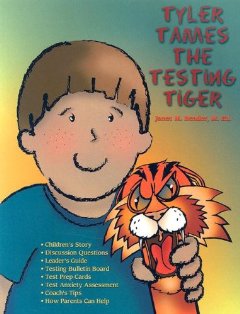
The STAAR test is around the corner and I'm noticing and hearing a lot about the students feeling worried and stressed about these tests. Test anxiety is a real issue and can cause difficulties for many people.
We are working on test anxiety and coping strategies in third, fourth and fifth grade social groups. We are using this book to discuss these issues. We started by filling out the self assessment that is included in the book. The self assessment has the student check things that apply to them in regards to test anxiety. It's important for students to understand how they feel when they are feeling anxious and that other people feel this way too, so they are not feeling alone.
Then, we read the book and discussed how Tyler dealt with test anxiety. After that, we discussed in depth the various coping strategy "prep cards". The students shared what strategies they felt would work best for them.
Next week, we will continue our test anxiety unit. I will add to this entry after we complete those activities.
We are working on test anxiety and coping strategies in third, fourth and fifth grade social groups. We are using this book to discuss these issues. We started by filling out the self assessment that is included in the book. The self assessment has the student check things that apply to them in regards to test anxiety. It's important for students to understand how they feel when they are feeling anxious and that other people feel this way too, so they are not feeling alone.
Then, we read the book and discussed how Tyler dealt with test anxiety. After that, we discussed in depth the various coping strategy "prep cards". The students shared what strategies they felt would work best for them.
Next week, we will continue our test anxiety unit. I will add to this entry after we complete those activities.
Wall of Kindness
I usually do this activity at the beginning of February, since it lends itself to a cute bulletin board for Valentine's Day! I start with reading one of my favorite books, Kindness is Cooler, Mrs. Ruler by Margery Cuyler. Click here to learn more about this adorable book. In the book, they have a class project where they do acts of kindness and then write those acts on paper hearts to make a Wall of Kindness. After reading the book, we discuss what acts of kindness we have done. We write those acts on paper hearts to make our own Wall of Kindness. See below for a picture of our awesome bulletin board!
We Can Light Up the World With Kindness!
Isn't this bulletin board so cute?! I don't mean to brag, but I'm pretty proud of how it turned out! What's even more impressive were the great ideas my students contributed. We discussed that the holidays (whatever holidays you celebrate) are a great time to demonstrate kindness to others. We talked about acts of kindness that we wanted to do for someone else during the month of December. I tried to focus the acts of kindness on things that the students would plan to do and then execute versus something kind that they have already done. My example for the students was that I am donating food to a homeless shelter this month.
Each student got a lightbulb and colored it and then wrote their plan of kindness on the lightbulb. Then we added them to black construction paper "wire" that I cut out. The result turned out super cute and the kids were really thinking about kind things they could do with others. Win win!
Each student got a lightbulb and colored it and then wrote their plan of kindness on the lightbulb. Then we added them to black construction paper "wire" that I cut out. The result turned out super cute and the kids were really thinking about kind things they could do with others. Win win!
What is a Thought? (A Thought is a Lot!)

This book is a great tool for explaining what thoughts are and the power that they have. There is a teaching CD that comes with the book with lessons and reproducible teaching supports.
We start by reading the book and discussing. From there, I am picking specific lessons from the teaching CD based on the needs of my students. The activity we started with involved how our thoughts affect our feelings. We used a parachute and discussed various scenarios and then represented the feelings we felt in those situations with the parachute. For example, when we are sleeping, we feel calm so we calmly swayed the parachute. When someone yells at us, we are angry, so we vigorously shook the parachute. This gave a great visual representation of what feelings would "look" like if we could see them. Next sessions, we will be talking about calm thoughts vs. mixed up thoughts and the thoughts, feelings, behavior chain connection. I will add to this entry after we complete those activities. I highly recommend this book for social thinking support.
We start by reading the book and discussing. From there, I am picking specific lessons from the teaching CD based on the needs of my students. The activity we started with involved how our thoughts affect our feelings. We used a parachute and discussed various scenarios and then represented the feelings we felt in those situations with the parachute. For example, when we are sleeping, we feel calm so we calmly swayed the parachute. When someone yells at us, we are angry, so we vigorously shook the parachute. This gave a great visual representation of what feelings would "look" like if we could see them. Next sessions, we will be talking about calm thoughts vs. mixed up thoughts and the thoughts, feelings, behavior chain connection. I will add to this entry after we complete those activities. I highly recommend this book for social thinking support.
Yoga!
Yoga is a great strategy for coping with all kinds of things! We discussed how it can help us to calm down, release energy, and cope with anxiety and stress. As a group, we did this yoga practice for kids found on Youtube from Yoga Today. It is a fun and quick 9 minute practice for kids. The kids really enjoyed practicing these poses. Then we discussed how they felt afterwards and I scribed their thoughts on chart paper. See the picture below to read their insights. They definitely learned a lot! We also discussed the benefits of focusing on deep breathing, as this is a strategy that can help everyone. In Lunch Bunch, we played the game, Yogarilla. This is a fun game for kids to play and practice different poses. We are incorporating more yoga into our sensory breaks and the kids are learning more about how it can help them. I encourage them to practice at home as well. The more they practice and get used to the poses, the more they will understand the benefits. Have fun. Do yoga!

